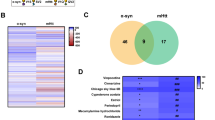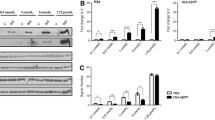Abstract
Statins, 3-hydroxy-3-methylglutaryl-coenzyme A (HMG-CoA) reductase inhibitors, have been reported to attenuate amyloid-β peptide (Aβ) production in various cellular models. However, the mechanisms by which statins affect neuronal Aβ production have not yet been clarified. Here, we investigated this issue in rat primary cortical neurons using two statins, pitavastatin (PV) and atorvastatin (AV). Treatment of neurons with 0.2–2.5 μM PV or AV for 4 days induced a concentration- and time-dependent reduction in the secretion of both Aβ40 and Aβ42. Moreover, Western blot analyses of cell lysates showed that treatment with PV or AV significantly reduced expression levels of the mature form of amyloid precursor protein (APP) and Thr668-phosphorylated APP (P-APP), but not immature form of APP; the decreases in P-APP levels were more notable than those of mature APP levels. The statin treatment did not alter expression of BACE1 (β-site APP-cleaving enzyme 1) or γ-secretase complex proteins (presenilin 1, nicastrin, APH-1, and PEN-2). In neurons overexpressing APP via recombinant adenoviruses, PV or AV similarly reduced Aβ secretion and the levels of mature APP and P-APP. Statins also markedly reduced cellular cholesterol content in neurons in a concentration-dependent manner. Co-treatment with mevalonate reversed the statin-induced decreases in Aβ secretion and mature APP and P-APP levels, whereas co-treatment with cholesterol did not, despite recovery of cellular cholesterol levels. Finally, cell-surface biotinylation experiments revealed that both statins significantly reduced the levels of cell-surface P-APP without changing those of cell surface mature APP. These results suggest that statins reduce Aβ production by selectively modulating APP maturation and phosphorylation through a mechanism independent of cholesterol reduction in cultured neurons.







Similar content being viewed by others
References
Hardy J, Selkoe DJ (2002) The amyloid hypothesis of Alzheimer’s disease: progress and problems on the road to therapeutics. Science 297:353–356
De Strooper B (2010) Proteases and proteolysis in Alzheimer disease: a multifactorial view on the disease process. Physiol Rev 90:465–494
van der Most PJ, Dolga AM, Nijholt IM, Luiten PG, Eisel UL (2009) Statins: mechanisms of neuroprotection. Prog Neurobiol 88:64–75
Pac-Soo C, Lloyd DG, Vizcaychipi MP, Ma D (2011) Statins: the role in the treatment and prevention of Alzheimer’s neurodegeneration. J Alzheimers Dis 27:1–10
Fonseca AC, Resende R, Oliveira CR, Pereira CM (2010) Cholesterol and statins in Alzheimer’s disease: current controversies. Exp Neurol 223:282–293
Shepardson NE, Shankar GM, Selkoe DJ (2011) Cholesterol level and statin use in Alzheimer disease: I. Review of epidemiological and preclinical studies. Arch Neurol 68:1239–1244
Shepardson NE, Shankar GM, Selkoe DJ (2011) Cholesterol level and statin use in Alzheimer disease: II. Review of human trials and recommendations. Arch Neurol 68:1385–1392
Jick H, Zornberg GL, Jick SS, Seshadri S, Drachman DA (2000) Statins and the risk of dementia. Lancet 356:1627–1631
Wolozin B, Kellman W, Ruosseau P, Celesia GG, Siegel G (2000) Decreased prevalence of Alzheimer disease associated with 3-hydroxy-3-methyglutaryl coenzyme A reductase inhibitors. Arch Neurol 57:1439–1443
Green RC, McNagny SE, Jayakumar P, Cupples LA, Benke K et al (2006) Statin use and the risk of Alzheimer’s disease: the MIRAGE study. Alzheimers Dement 2:96–103
Cramer C, Haan MN, Galea S, Langa KM, Kalbfleisch JD (2008) Use of statins and incidence of dementia and cognitive impairment without dementia in a cohort study. Neurology 71:344–350
Haag MD, Hofman A, Koudstaal PJ, Stricker BH, Breteler MM (2009) Statins are associated with a reduced risk of Alzheimer disease regardless of lipophilicity. The Rotterdam Study. J Neurol Neurosurg Psychiatry 80:13–17
Li G, Shofer JB, Rhew IC, Kukull WA, Peskind ER et al (2010) Age-varying association between statin use and incident Alzheimer’s disease. J Am Geriatr Soc 58:1311–1317
Buxbaum JD, Geoghagen NS, Friedhoff LT (2001) Cholesterol depletion with physiological concentrations of a statin decreases the formation of the Alzheimer amyloid Aβ peptide. J Alzheimers Dis 3:221–229
Cole SL, Grudzien A, Manhart IO, Kelly BL, Oakley H et al (2005) Statins cause intracellular accumulation of amyloid precursor protein, β-secretase-cleaved fragments, and amyloid β-peptide via an isoprenoid-dependent mechanism. J Biol Chem 280:18755–18770
Simons M, Keller P, De Strooper B, Beyreuther K, Dotti CG et al (1998) Cholesterol depletion inhibits the generation of β-amyloid in hippocampal neurons. Proc Natl Acad Sci USA 95:6460–6464
Fassbender K, Simons M, Bergmann C, Stroick M, Lutjohann D et al (2001) Simvastatin strongly reduces levels of Alzheimer’s disease β-amyloid peptides Aβ42 and Aβ40 in vitro and in vivo. Proc Natl Acad Sci USA 98:5856–5861
Ostrowski SM, Wilkinson BL, Golde TE, Landreth G (2007) Statins reduce amyloid-β production through inhibition of protein isoprenylation. J Biol Chem 282:26832–26844
Won JS, Im YB, Khan M, Contreras M, Singh AK et al (2008) Lovastatin inhibits amyloid precursor protein (APP) β-cleavage through reduction of APP distribution in Lubrol WX extractable low density lipid rafts. J Neurochem 105:1536–1549
Petanceska SS, DeRosa S, Olm V, Diaz N, Sharma A et al (2002) Statin therapy for Alzheimer’s disease: will it work? J Mol Neurosci 19:155–161
Chauhan NB, Siegel GJ, Feinstein DL (2004) Effects of lovastatin and pravastatin on amyloid processing and inflammatory response in TgCRND8 brain. Neurochem Res 29:1897–1911
Burns MP, Igbavboa U, Wang L, Wood WG, Duff K (2006) Cholesterol distribution, not total levels, correlate with altered amyloid precursor protein processing in statin-treated mice. Neuromol Med 8:319–328
Tong XK, Nicolakakis N, Fernandes P, Ongali B, Brouillette J et al (2009) Simvastatin improves cerebrovascular function and counters soluble amyloid-β, inflammation and oxidative stress in aged APP mice. Neurobiol Dis 35:406–414
Kurata T, Miyazaki K, Kozuki M, Panin VL, Morimoto N et al (2011) Atorvastatin and pitavastatin improve cognitive function and reduce senile plaque and phosphorylated tau in aged APP mice. Brain Res 1371:161–170
Araki W (2010) Beta- and gamma-secretases and lipid rafts. Open Biol J 3:16–20
Vetrivel KS, Thinakaran G (2010) Membrane rafts in Alzheimer’s disease β-amyloid production. Biochim Biophys Acta 1801:860–867
Kametani F, Tanaka K, Ishii T, Ikeda S, Kennedy HE et al (1993) Secretory form of Alzheimer amyloid precursor protein 695 in human brain lacks β/A4 amyloid immunoreactivity. Biochem Biophys Res Commun 191:392–398
Golde TE, Estus S, Younkin LH, Selkoe DJ, Younkin SG (1992) Processing of the amyloid protein precursor to potentially amyloidogenic derivatives. Science 255:728–730
Luo WJ, Wang H, Li H, Kim BS, Shah S et al (2003) PEN-2 and APH-1 coordinately regulate proteolytic processing of presenilin 1. J Biol Chem 278:7850–7854
Brewer GJ, Torricelli JR, Evege EK, Price PJ (1993) Optimized survival of hippocampal neurons in B27-supplemented Neurobasal, a new serum-free medium combination. J Neurosci Res 35:567–576
Motoki K, Kume H, Oda A, Tamaoka A, Hosaka A et al (2012) Neuronal β-amyloid generation is independent of lipid raft association of β-secretase BACE1: analysis with a palmitoylation-deficient mutant. Brain Behav 2:270–282
Takeda K, Araki W, Tabira T (2004) Enhanced generation of intracellular Aβ42 amyloid peptide by mutation of presenilins PS1 and PS2. Eur J Neurosci 19:258–264
Oda A, Tamaoka A, Araki W (2010) Oxidative stress up-regulates presenilin 1 in lipid rafts in neuronal cells. J Neurosci Res 88:1137–1145
Takeda K, Araki W, Akiyama H, Tabira T (2004) Amino-truncated amyloid β-peptide (Aβ5-40/42) produced from caspase-cleaved amyloid precursor protein is deposited in Alzheimer’s disease brain. FASEB J 18:1755–1757
Araki W, Yuasa K, Takeda S, Takeda K, Shirotani K et al (2001) Pro-apoptotic effect of presenilin 2 (PS2) overexpression is associated with down-regulation of Bcl-2 in cultured neurons. J Neurochem 79:1161–1168
Fluhrer R, Capell A, Westmeyer G, Willem M, Hartung B et al (2002) A non-amyloidogenic function of BACE-2 in the secretory pathway. J Neurochem 81:1011–1020
Murayama KS, Kametani F, Araki W (2005) Extracellular release of BACE1 holoproteins from human neuronal cells. Biochem Biophys Res Commun 338:800–807
Shinohara M, Sato N, Kurinami H, Takeuchi D, Takeda S et al (2010) Reduction of brain β-amyloid (Aβ) by fluvastatin, a hydroxymethylglutaryl-CoA reductase inhibitor, through increase in degradation of amyloid precursor protein C-terminal fragments (APP-CTFs) and Aβ clearance. J Biol Chem 285:22091–22102
Hamadmad SN, Hohl RJ (2007) Lovastatin suppresses erythropoietin receptor surface expression through dual inhibition of glycosylation and geranylgeranylation. Biochem Pharmacol 74:590–600
Kojro E, Gimpl G, Lammich S, Marz W, Fahrenholz F (2001) Low cholesterol stimulates the nonamyloidogenic pathway by its effect on the α-secretase ADAM 10. Proc Natl Acad Sci USA 98:5815–5820
Parvathy S, Ehrlich M, Pedrini S, Diaz N, Refolo L et al (2004) Atorvastatin-induced activation of Alzheimer’s alpha secretase is resistant to standard inhibitors of protein phosphorylation-regulated ectodomain shedding. J Neurochem 90:1005–1010
Pedrini S, Carter TL, Prendergast G, Petanceska S, Ehrlich ME et al (2005) Modulation of statin-activated shedding of Alzheimer APP ectodomain by ROCK. PLoS Med 2:e18
Kojro E, Fuger P, Prinzen C, Kanarek AM, Rat D et al (2010) Statins and the squalene synthase inhibitor zaragozic acid stimulate the non-amyloidogenic pathway of amyloid-β protein precursor processing by suppression of cholesterol synthesis. J Alzheimers Dis 20:1215–1231
Araki W, Kume H, Oda A, Tamaoka A, Kametani F (2009) IGF-1 promotes β-amyloid production by a secretase-independent mechanism. Biochem Biophys Res Commun 380:111–114
Lee MS, Kao SC, Lemere CA, Xia W, Tseng HC et al (2003) APP processing is regulated by cytoplasmic phosphorylation. J Cell Biol 163:83–95
Sodhi CP, Perez RG, Gottardi-Littell NR (2008) Phosphorylation of β-amyloid precursor protein (APP) cytoplasmic tail facilitates amyloidogenic processing during apoptosis. Brain Res 1198:204–212
Yoon SO, Park DJ, Ryu JC, Ozer HG, Tep C et al (2012) JNK3 perpetuates metabolic stress induced by Abeta peptides. Neuron 75:824–837
Tamboli IY, Barth E, Christian L, Siepmann M, Kumar S et al (2010) Statins promote the degradation of extracellular amyloid β-peptide by microglia via stimulation of exosome-associated insulin-degrading enzyme (IDE) secretion. J Biol Chem 285:37405–37414
Pahan K, Sheikh FG, Namboodiri AM, Singh I (1997) Lovastatin and phenylacetate inhibit the induction of nitric oxide synthase and cytokines in rat primary astrocytes, microglia, and macrophages. J Clin Invest 100:2671–2679
Cordle A, Landreth G (2005) 3-Hydroxy-3-methylglutaryl-coenzyme a reductase inhibitors attenuate β-amyloid-induced microglial inflammatory responses. J Neurosci 25:299–307
Lindberg C, Crisby M, Winblad B, Schultzberg M (2005) Effects of statins on microglia. J Neurosci Res 82:10–19
Li B, Mahmood A, Lu D, Wu H, Xiong Y et al (2009) Simvastatin attenuates microglial cells and astrocyte activation and decreases interleukin-1β level after traumatic brain injury. Neurosurgery 65:179–185 discussion 185–176
Clarke RM, O’Connell F, Lyons A, Lynch MA (2007) The HMG-CoA reductase inhibitor, atorvastatin, attenuates the effects of acute administration of amyloid-β1-42 in the rat hippocampus in vivo. Neuropharmacology 52:136–145
Johnson-Anuna LN, Eckert GP, Franke C, Igbavboa U, Muller WE et al (2007) Simvastatin protects neurons from cytotoxicity by up-regulating Bcl-2 mRNA and protein. J Neurochem 101:77–86
Fonseca AC, Proenca T, Resende R, Oliveira CR, Pereira CM (2009) Neuroprotective effects of statins in an in vitro model of Alzheimer’s disease. J Alzheimers Dis 17:503–517
Acknowledgments
We thank Drs. Fuyuki Kametani, Steven G. Younkin, Goapal Thinakaran for anti-APP C-terminal, anti-APP N-terminal, and anti-PEN-2 antibodies, respectively. This work was supported by Grants from the Ministry of Health, Labor, and Welfare, Japan, and a Grant-in-Aid for Scientific Research (C) from the Ministry of Education, Culture, Sports, Science and Technology, Japan.
Conflict of interest
All the authors declared no competing interests.
Author information
Authors and Affiliations
Corresponding author
Electronic supplementary material
Below is the link to the electronic supplementary material.
Rights and permissions
About this article
Cite this article
Hosaka, A., Araki, W., Oda, A. et al. Statins Reduce Amyloid β-Peptide Production by Modulating Amyloid Precursor Protein Maturation and Phosphorylation Through a Cholesterol-Independent Mechanism in Cultured Neurons. Neurochem Res 38, 589–600 (2013). https://doi.org/10.1007/s11064-012-0956-1
Received:
Revised:
Accepted:
Published:
Issue Date:
DOI: https://doi.org/10.1007/s11064-012-0956-1




